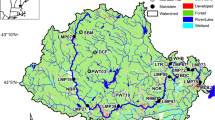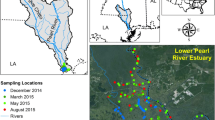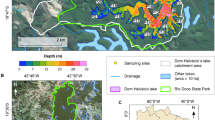Abstract
Dissolved organic matter (DOM) influences the physical, chemical, and biological properties of aquatic ecosystems. We hypothesized that controls over spatial variation in DOM quantity and composition (measured with DOM optical properties) differ based on the source of DOM to aquatic ecosystems. DOM quantity and composition should be better predicted by land cover in aquatic habitats with allochthonous DOM and related more strongly to nutrients in aquatic habitats with autochthonous DOM. Three habitat types [rivers (R), rivermouths (RM), and the nearshore zone (L)] associated with 23 tributaries of the Laurentian Great Lakes were sampled to test this prediction. Evidence from optical indices suggests that DOM in these habitats generally ranged from allochthonous (R sites) to a mix of allochthonous-like and autochthonous-like (L sites). Contrary to expectations, DOM properties such as the fluorescence index, humification index, and spectral slope ratio were only weakly related to land cover or nutrient data (Bayesian R 2 values were indistinguishable from zero). Strongly supported models in all habitat types linked DOM quantity (that is, dissolved organic carbon concentration [DOC]) to both land cover and nutrients (Bayesian R 2 values ranging from 0.55 to 0.72). Strongly supported models predicting DOC changed with habitat type: The most important predictor in R sites was wetlands whereas the most important predictor at L sites was croplands. These results suggest that as the DOM pool becomes more autochthonous-like, croplands become a more important driver of spatial variation in DOC and wetlands become less important.



Similar content being viewed by others
References
Aitkenhead JA, McDowell WH. 2000. Soil C:N ratio as a predictor of annual riverine DOC flux at local and global scales. Glob Biogeochem Cycles 14:127–38.
Beman M, Arrigo K, Matson P. 2005. Agricultural runoff fuels large phytoplankton blooms in vulnerable areas of the ocean. Nature 434:211–14.
Best N, Lunn D. 2007. The BRugs Package.
Bianchi TS. 2011. The role of terrestrially derived organic carbon in the coastal ocean: a changing paradigm and the priming effect. Proc Natl Acad Sci USA 108:19473–81.
Biddanda BA, Cotner JB. 2002. Love handles in aquatic ecosystems: the role of dissolved organic carbon drawdown, resuspended sediments, and terrigenous inputs in the carbon balance of Lake Michigan. Ecosystems 5:431–45.
Biddanda BA, Cotner JB. 2003. Enhancement of dissolved organic matter bioavailability by sunlight and its role in the carbon cycle of Lakes Superior and Michigan. J Great Lakes Res 29:228–41.
Burnham KP, Anderson DR. 1998. Model selection and inference a practical information-theoretic approach. New York, NY: Springer.
Burnham KP, Anderson DR. 2001. Kullback–Leibler information as a basis for strong inference in ecological studies. Wildl Res 28:111–19.
Carlin BP, Louis TA. 2008. Bayesian methods for data analysis. 3rd edn. Boca Raton, FL: Chapman & Hall/CRC.
Cory R, Miller M, McKnight DM, Guerard JJ, Miller PL. 2010. Effect of instrument-specific response on the analysis of fulvic acid fluorescence spectra. Limnol Oceanogr Methods 8:67–78.
Dodds WK. 2003. The role of periphyton in phosphorus retention in shallow freshwater aquatic systems. J Phycol 39:840–9.
Ellison AM. 2004. Bayesian inference in ecology. Ecol Lett 7:509–20.
ESRI. 2011. ArcGIS Desktop.
Frost PC, Larson JH, Johnston CA, Young KC, Maurice PA, Lamberti GA, Bridgham SD. 2006. Landscape predictors of stream dissolved organic matter concentration and physicochemistry in a Lake Superior river watershed. Aquat Sci 68:40–51.
Fry J, Xian G, Jin S, Dewitz J, Homer C, Yang L, Barnes C, Herold N, Wickham J. 2011. Completion of the 2006 national land cover database for the conterminous United States. Photogramm Eng Remote Sens 77:858–64.
Gergel SE, Turner MG, Kratz TK. 1999. Dissolved organic carbon as an indicator of the scale of watershed influence on lakes and rivers. Ecol Appl 9:1377–90.
Graeber D, Gelbrecht J, Pusch M, Anlanger C, von Schiller D. 2012. Agriculture has changed the amount and composition of dissolved organic matter in Central European headwater streams. Sci Total Environ 438:435–46.
Guo W, Stedmon CA, Han Y, Wu F, Yu X, Hu M. 2007. The conservative and non-conservative behavior of chromophoric dissolved organic matter in Chinese estuarine waters. Mar Chem 107:357–66.
Hair JF, Anderson RE, Tatham RL, Black WC. 1998. Multivariate data analysis. 5th edn. Upper Saddle River, NJ: Prentic-Hall.
Heathcote AJ, Downing JA. 2011. Impacts of eutrophication on carbon burial in freshwater lakes in an intensively agricultural landscape. Ecosystems 15:60–70.
Helms JR, Stubbins A, Ritchie JD, Minor EC, Kieber DJ, Mopper K. 2008. Absorption spectral slopes and slope ratios as indicators of molecular weight, source, and photobleaching of chromophoric dissolved organic matter. Limnol Oceanogr 53:955–69.
Hernes PJ, Benner R. 2003. Photochemical and microbial degradation of dissolved lignin phenols: implications for the fate of terrigenous dissolved organic matter in marine environments. J Geophys Res 108.
Hiriart-Baer VP, Diep N, Smith REH. 2008. Dissolved organic matter in the Great Lakes : role and nature of allochthonous material. J Great Lakes Res 34:383–94.
Jaffé R, McKnight D, Maie N, Cory R, McDowell WH, Campbell JL. 2008. Spatial and temporal variations in DOM composition in ecosystems: the importance of long-term monitoring of optical properties. J Geophys Res 113:G04032.
Kaplan LA, Bott TL. 1982. Diel fluctuations of DOC generated by algae in a piedmont stream. Limnol Oceanogr 27:1091–100.
Kufel L, Kufel I. 2002. Chara beds acting as nutrient sinks in shallow lakes—a review. Aquat Bot 72:249–60.
Larson J, Trebitz A, Steinman A, Wiley MJ, Mazur MC, Pebbles V, Braun HA. 2013. Great Lakes rivermouth ecosystems: scientific synthesis and management implications. J Great Lakes Res 39:513–24.
Larson JH, Frost PC, Lodge DM, Lamberti GA. 2007a. Photodegradation of dissolved organic matter in forested streams of the northern Great Lakes region. J North Am Benthol Soc 61:35–425.
Larson JH, Frost PC, Zheng Z, Johnston CA, Bridgham SD, Lodge DM, Lamberti GA. 2007b. Effects of upstream lakes on dissolved organic matter in streams. Limnol Oceanogr 52:60–9.
Lutz BD, Bernhardt ES, Roberts BJ, Cory RM, Mulholland PJ. 2012. Distinguishing dynamics of dissolved organic matter components in a forested stream using kinetic enrichments. Limnol Oceanogr 57:76–89.
Maranger R, Pullin MJ. 2003. Elemental complexation by dissolved organic matter in lakes: implications for Fe speciation and the bioavailability of Fe and P. In: Findlay SEG, Sinsabaugh RL, Eds. Aquatic ecosystems: interactivity of dissolved organic matter. San Diego, CA: Academic. p 186–206.
Marín-Spiotta E, Gruley KE, Crawford J, Atkinson EE, Miesel JR, Greene S, Cardona-Correa C, Spencer RGM. 2014. Paradigm shifts in soil organic matter research affect interpretations of aquatic carbon cycling: transcending disciplinary and ecosystem boundaries. Biogeochemistry 117:279–97.
Mattsson T, Kortelainen P, Laubel A, Evans D, Pujo-Pay M, Räike A, Conan P. 2009. Export of dissolved organic matter in relation to land use along a European climatic gradient. Sci Total Environ 407:1967–76.
McCallister S, Bauer J, Cherrier J, Ducklow HW. 2004. Assessing sources and ages of organic matter supporting river and estuarine bacterial production: a multiple-isotope (Δ 14 C, δ 13 C, and δ 15 N) approach. Limnol Oceanogr 49:1687–702.
McCarthy M. 2007. Bayesian methods for ecology. New York, NY: Cambridge University Press.
McClain ME, Boyer EW, Dent CL, Gergel SE, Grimm NB, Groffman PM, Hart SC, Harvey JW, Johnston C, Mayorga E, McDowell WH, Pinay G. 2003. Biogeochemical hot spots and hot moments at the interface of terrestrial and aquatic ecosystems. Ecosystems 6:301–12.
McKnight DM, Boyer EW, Westerhoff PK, Doran PT, Kulbe T, Andersen DT. 2001. Spectrofluorometric characterization of dissolved organic matter for indication of precursor organic material and aromaticity. Limnol Oceanogr 46:38–48.
Minor EC, Dalzell BJ, Stubbins A, Mopper K. 2007. Evaluating the photoalteration of estuarine dissolved organic matter using direct temperature-resolved mass spectrometry and UV–visible spectroscopy. Aquat Sci 69(440):455.
Mulholland PJ. 2002. Large-scale patterns in dissolved organic carbon concentration, flux, and sources. In: Findlay S, Sinsabaugh RL, Eds. Aquatic ecosystems: interactivity of dissolved organic matter. San Diego, CA: Academic. p 139.
Murphy KR, Butler KD, Spencer RGM, Stedmon CA, Boehme JR, Aiken GR. 2010. Measurement of dissolved organic matter fluorescence in aquatic environments: an interlaboratory comparison. Environ Sci Technol 44:9405–12.
Neff B, Nicholas J. 2005. Uncertainty in the great lakes water balance scientific investigations report 2004-5100.
Ntzoufras I. 2009. Bayesian modeling in WinBugs. Hoboken, NJ: Wiley.
Ohno T. 2002. Fluorescence inner-filtering correction for determining the humification index of dissolved organic matter. Environ Sci Technol 36:742–6.
Parlanti E, Wörz K, Geoffroy L, Lamotte M. 2000. Dissolved organic matter fluorescence spectroscopy as a tool to estimate biological activity in a coastal zone submitted to anthropogenic inputs. Org Geochem 31:1765–81.
Petrone KC, Fellman JB, Hood E, Donn MJ, Grierson PF. 2011. The origin and function of dissolved organic matter in agro-urban coastal streams. J Geophys Res 116:G01028.
Prairie YT. 2008. Carbocentric limnology : looking back, looking forward. Can J Fish Aquat Sci 65:543–8.
R Development Core Team. 2010. R: A language and environment for statistical computing.
Robertson DM, Saad DA. 2011. Nutrient inputs to the Laurentian Great Lakes by source and watershed estimated using SPARROW watershed models. J Am Water Resour Assoc 47:1011–33.
Royer TV, David MB. 2005. Export of dissolved organic carbon from agricultural streams in Illinois, USA. Aquat Sci 67:465–71.
Soballe DM, Fischer JR. 2004. Long term resource monitoring program procedures: Water quality monitoring. Technical Report LTRMP 2004-T02-1 (Ref. 95-POO2-5). La Crosse, WI.
Stephens BM, Minor EC. 2010. DOM characteristics along the continuum from river to receiving basin: a comparison of freshwater and saline transects. Aquat Sci 72:403–17.
Trabelsi A, Rassoulzadegan F. 2011. Inorganic nutrient control of dissolved organic carbon (DOC) dynamics in NW Mediterranean waters: an experimental approach. Mar Biol Res 7:667–76.
Tranvik L, Downing J, Cotner J. 2009. Lakes and reservoirs as regulators of carbon cycling and climate. Limnol Oceanogr 54:2298–314.
Trebitz AS. 2006. Characterizing seiche and tide-driven daily water level fluctuations affecting coastal ecosystems of the Great Lakes. J Great Lakes Res 32:102–16.
Wade P. 2000. Bayesian methods in conservation biology. Conserv Biol 14:1308–16.
Webster KE, Soranno PA, Cheruvelil KS, Bremigan MT, Downing JA, Vaux PD, Asplund TR, Bacon LC, Connor J. 2008. An empirical evaluation of the nutrient-color paradigm for lakes. Limnol Oceanogr 53:1137–48.
Weishaar JL, Aiken GR, Bergamaschi BA, Fram MS, Fujii R, Mopper K. 2003. Evaluation of specific ultraviolet absorbance as an indicator of the chemical composition and reactivity of dissolved organic carbon. Environ Sci Technol 37:4702–8.
Wetzel RG. 2001. Limnology. 3rd edn. Amsterdam: Academic.
Williams C, Frost P, Xenopoulos M. 2013. Beyond best management practices: pelagic biogeochemical dynamics in urban stormwater ponds. Ecol Appl 23:1384–95.
Williams CJ, Yamashita Y, Wilson HF, Jaffé R, Xenopoulos MA. 2010. Unraveling the role of land use and microbial activity in shaping dissolved organic matter characteristics in stream ecosystems. Limnol Oceanogr 55:1159–71.
Wilson HF, Xenopoulos MA. 2008. Ecosystem and seasonal control of stream dissolved organic carbon along a gradient of land use. Ecosystems 11:555–68.
Wilson HF, Xenopoulos MA. 2009. Effects of agricultural land use on the composition of fluvial dissolved organic matter. Nat Geosci 2:37–41.
Zsolnay A, Baigar E, Jimenez M, Steinweg B, Saccomandi F. 1999. Differentiating with fluorescence spectroscopy the sources of dissolved organic matter in soils subjected to drying. Chemosphere 38:45–50.
Zweifel U, Norrman B, Hagstrom A. 1993. Consumption of dissolved organic carbon by marine bacteria and demand for inorganic nutrients. Mar Ecol Progr Ser 101:23–32.
Acknowledgments
Many people contributed to the collection of this data, including J. Veldboom, B. Knights, R. Kennedy and A. Milde. Funding was provided by the Great Lakes Restoration Initiative (Project #82). Some aspects of the sampling design reflect conversations with J. Schaeffer, M. Carlson-Mazur and P. Seelbach. Thanks to the Old Woman Creek National Estuarine Research Reserve and the Ottawa National Wildlife Refuge for access to sampling sites. Discussions with members of the Rivermouth Collaboratory also aided the development of ideas associated with this manuscript. Any use of trade, product, or firm names is for descriptive purposes only and does not imply endorsement by the U.S. Government.
Author information
Authors and Affiliations
Corresponding author
Additional information
Author contributions
All author contributed to conceiving the ideas, collecting the data and preparation of the manuscript.
Electronic supplementary material
Below is the link to the electronic supplementary material.
Rights and permissions
About this article
Cite this article
Larson, J.H., Frost, P.C., Xenopoulos, M.A. et al. Relationships Between Land Cover and Dissolved Organic Matter Change Along the River to Lake Transition. Ecosystems 17, 1413–1425 (2014). https://doi.org/10.1007/s10021-014-9804-2
Received:
Accepted:
Published:
Issue Date:
DOI: https://doi.org/10.1007/s10021-014-9804-2




